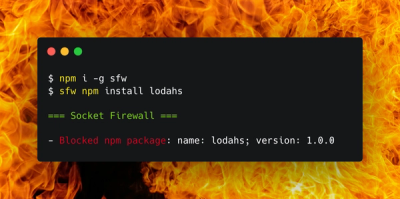
Security News
Package Maintainers Call for Improvements to GitHub’s New npm Security Plan
Maintainers back GitHub’s npm security overhaul but raise concerns about CI/CD workflows, enterprise support, and token management.
The Hunspell binding for nodejs that exposes as much of hunspell as possible and also adds new features. Hunspell is a first class spellcheck library used by Google, Apple, and Mozilla.
Nodehun aims to expose as much of hunspell's functionality as possible in an easy to understand and maintainable way, while also maintaining the performance characteristics expected of a responsible node module.
npm install nodehun
If you run into any build errors, make sure you satisfy the requirements for node-gyp.
import { Nodehun } from 'nodehun'
const fs = require('fs')
const affix = fs.readFileSync('path/to/*.aff')
const dictionary = fs.readFileSync('path/to/*.dic')
const nodehun = new Nodehun(affix, dictionary)
// Promise example
nodehun.suggest('colour')
.then(suggestions => { })
// async/await example
async function example() {
const suggestions = await nodehun.suggest('colour')
}
// sync example
const suggestions = nodehun.suggestSync('colour')
Note: It's probably not a good idea to use readFileSync in production.
The API now reflects hunspell's API almost exactly. Please see src/Nodehun.d.ts for the API exposed by v3.
Unlike Nodehun2, suggestSync for a word spelled correctly returns null instead of an empty array.
For example:
nodehun2.spellSuggestionsSync('color') // => []
nodehun3.suggestSync('color') // => null
There are performance gains to be seen for those who wrapped the library in promises.


To run the tests on your machine, execute npm run performance-test and find the graphs in the test/performance folder.
To continue using the old version, use:
npm install --save node@2.0.12
Works with Node v11 or lower, but some have reported compilation issues in v10 and v11. If you plan to use this version, please refer to the old readme file.
The following section includes short examples of various exposed operations.
For complete examples, see the /examples directory.
Nodehun offers a method that returns true or false if the passed word exists in the dictionary, i.e. is "correct".
await nodehun.spell('color') // => true
await nodehun.spell('colour') // => false, assuming en_US dictionary
Nodehun also offers a method that returns an array of words that could possibly match a misspelled word, ordered by most likely to be correct.
await nodehun.suggest('color')
// => null (since it's correctly spelled)
await nodehun.suggest('calor')
// => ['carol','valor','color','cal or','cal-or','caloric','calorie']
Nodehun also can add another dictionary on top of an existing dictionary object at runtime (this means it is not permanent) in order to merge two dictionaries. Once again, please do not actually use readFileSync.
const en_CA = fs.readFileSync('./path/to/en_CA.dic');
await nodehun.suggest('colour') // => [ ...suggestions... ]
// because "colour" is not a defined word in the US English dictionary
await nodehun.addDictionary(en_CA)
await nodehun.suggest('colour') // => null
// (since the word is considered correctly spelled now)
Nodehun can also add a single word to a dictionary at runtime (this means it is not permanent) in order to have a custom runtime dictionary. If you know anything about Hunspell you can also add flags to the word.
await nodehun.suggest('colour') // => [ ...suggestions...]
// because "colour" is not a defined word in the US English dictionary
await nodehun.add('colour')
await nodehun.suggest('colour') // => null
// (since 'colour' is correct now)
Note: colouring will still be considered incorrect. See the the addWithAffix example below.
Like the method above, except it also applies the example word's affix definition to the new word.
await nodehun.suggest('colouring') // => [ ...suggestions...]
// because "colour" is not a defined word in the US English dictionary
await nodehun.addWithAffix('colour', 'color')
await nodehun.suggest('colouring') // => null
// (since 'colouring' is correct now)
Nodehun can also remove a single word from a dictionary at runtime (this means it is not permanent) in order to have a custom runtime dictionary. If you know anything about Hunspell this method will ignore flags and just strip words that match.
await nodehun.suggest('color') // => null (since the word is correctly spelled)
await nodehun.remove('color')
await nodehun.suggest('color') // => ['colon', 'dolor', ...etc ]
Nodehun exposes the Hunspell stem function which analyzes the roots of words. Consult the Hunspell documentation for further understanding.
await nodehun.stem('telling') // => [telling, tell]
Nodehun exposes the Hunspell analyze function which analyzes a word and return a morphological analysis. Consult the Hunspell documentation for further understanding.
await nodehun.analyze('telling')
// with the appropriate dictionaries files, it will return:
// => [' st:telling ts:0', ' st:tell ts:0 al:told is:Vg']
Nodehun exposes the Hunspell generate function which generates a variation of a word by matching the morphological structure of another word. Consult the Hunspell documentation for further understanding.
await nodehun.generate('telling', 'ran') // => [ 'told' ]
await nodehun.generate('told', 'run') // => [ 'tell' ]
There are synchronous versions of all the methods listed above, but they are not documented as they are only present for people who really know and understand what they are doing. I highly recommend looking at the C++ source code if you are going to use these methods in a production environment as the locks involved with them can create some counterintuitive situations. For example, if you were to remove a word synchronously while many different suggestion threads were working in the background the remove word method could take seconds to complete while it waits to take control of the read-write lock. This is obviously disastrous in a situation where you would be servicing many requests.
All files must be UTF-8 to work! When you download open office dictionaries don't assume that the file is UTF-8 just because it is being served as a UTF-8 file. You may have to convert the file using the iconv unix utility (easy enough to do) to UTF-8 in order for the files to work.
If you want to create a new Hunspell dictionary you will need a base affix file. I recommend simply using one of the base affix files from the open office dictionaries for the language you are creating a dictionary for. Once you get around to creating a dictionary read the hunspell documentation to learn how to properly flag the words. However, my guess is that the vast majority of people creating dictionaries out there will be creating a dictionary of proper nouns. Proper nouns simply require the "M" flag. This is what a dictionary of proper nouns might look like:
Aachen/M
aardvark/SM
Aaren/M
Aarhus/M
Aarika/M
Aaron/M
Notice that the "S" flag denotes a proper noun that isn't capitalized, otherwise look in the docs.
The included dictionaries were extracted from Libre Office. The Libre Office versions have a modified aff file that makes generate() and analyze() much more useful. However, any MySpell style dictionary will work. Here are a few sources:
Also, check out @wooorm's UTF-8 dictionary collection here.
Let the community know if you've found other dictionary repositories!
The following is a a list of commands and their descriptions which may help in development.
npm start: to jumpstart the development server. This will automatically recompile the
c++ source when changes are made and run the tests once more.
npm run start-test: if you don't want to continuously compile the c++ source, but do want
the tests to re-run when changes are made to the test files.
npm run build: to compile the addon once.
npm test: to run the tests once.
npm run performance-test: to run the performance tests and output updated graphs. (see test/performance)
Make node-gyp build faster by increasing the number of cores it uses:
export JOBS=max
npm run build # super fast now!
Special thanks to @nathanjsweet for his grass roots efforts with this project, including the hunspell-distributed package upon which this library relies to provide buffer-based Hunspell initialization.
FAQs
The Hunspell binding for nodejs that exposes as much of hunspell as possible and also adds new features. Hunspell is a first class spellcheck library used by Google, Apple, and Mozilla.
The npm package nodehun receives a total of 1,271 weekly downloads. As such, nodehun popularity was classified as popular.
We found that nodehun demonstrated a not healthy version release cadence and project activity because the last version was released a year ago. It has 2 open source maintainers collaborating on the project.
Did you know?

Socket for GitHub automatically highlights issues in each pull request and monitors the health of all your open source dependencies. Discover the contents of your packages and block harmful activity before you install or update your dependencies.

Security News
Maintainers back GitHub’s npm security overhaul but raise concerns about CI/CD workflows, enterprise support, and token management.

Product
Socket Firewall is a free tool that blocks malicious packages at install time, giving developers proactive protection against rising supply chain attacks.

Research
Socket uncovers malicious Rust crates impersonating fast_log to steal Solana and Ethereum wallet keys from source code.